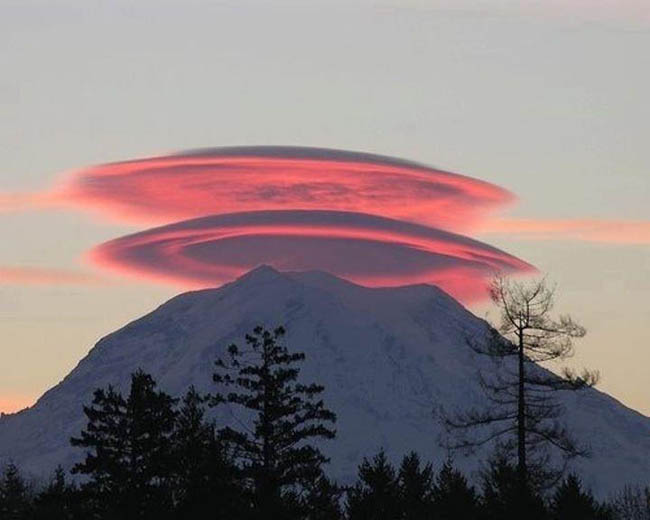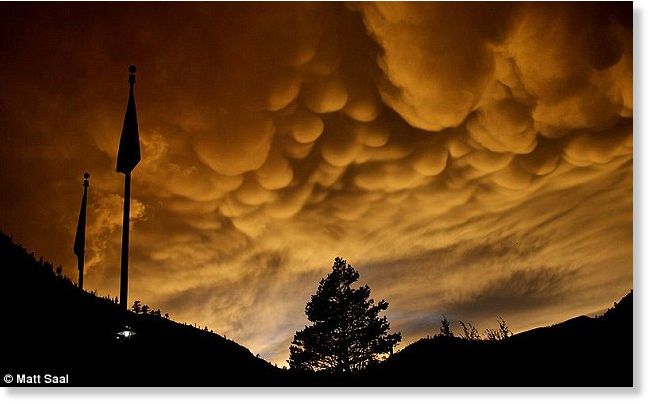Case I. Arioso: Lenticular Cloud
Photographed in Brazil
1968 Scientific Study of Unidentified Flying Objects by Edward Condon
The Arioso Case is filled with pictures of clouds and cloud
classifications. In my personal top 5 list of things that make me happy, fluffy
white cumulus clouds on bright blue skies is number 2. Clouds in general are
another one of my favorite things, and are one of my favorite topics in meteorology,
and one of my favorite things to teach in Earth Science. I love cloud classification, and I am
usually that person who will name drop the scientific
name of the cloud formation outside. I also love cloud watching and finding
shaped and pictures in the clouds. So naturally, this was my favorite case in
the Tempus Fugit exhibit. The Lenticular Cloud
photograph especially, since I knew what it was and with the lack of text and
information that I (along with most others) wished for, it was something I
could identify. Lenticular clouds are "lens" shaped (disc shaped) clouds and form in high altitudes. The images I have most often seen them with are
with tall mountains. These clouds are often mistaken for flying saucers since
they are so unusual looking.


Examples of more Lenticular Clouds
This picture was
used in Edward Condon's Scientific Study of Unidentified Flying Objects report
in 1968. The Air Force commissioned this study to provide a scientific approach
to UFO's and extraterrestrial activity. Condon explained most UFO sightings, including
Lenticular clouds scientifically, and found no evidence linking know UFO's and
aliens. There have been no large-scale studies on UFO's since this
report. This photo is from the American Philosophical Society's (APS) collection.
 |
| Case I: Arioso |
This object is on
display in the Arioso Case with other photographs of clouds. The artist statement explains that the exhibit is about how humans organize and measure time. Lisa Weidman, the
Associate Curator of Museum Education at APS, explained that this case may suggest as to why and how we name something
like clouds, and is there a right way to do so. As a scientist, I believe
absolutely. Classification is important. From an artistic perspective however,
I can understand, how something such as clouds that are always changing, how can
you classify them. The theme of the entire exhibition is time and clouds
do have a large role in the space, including the large video on display in the
center of the room, showing a cloud changing in space over time. Since clouds
are not permanent, why classify them? Back to being a scientist, I like how
NOAA (National Oceanic and Atmospheric Administration) has classified them
based on height and appearance. Cloud classification is necessary for
predicting future weather and atmosphere patterns.
 |
| Cloud images with their classifications |
 |
| Photo of cloud used in video display |
The display case,
like all other cases in the exhibition, did not have any text or information
about the pieces. Like the other cases in the exhibit, there was a book element in the case. Two more photos of lenticular clouds were on a book display. I do
not know if the book is from the museum's collection. There were also pictures
of clouds and their classifications, and a framed photo of the cloud used in
the video reflected upon itself. All the media in this case were photos of
clouds, providing a clear focus on the subject for this case rather than some
of the other cases that were more difficult to connect. I think clouds are an interesting
subject matter for expressing time and liked the artist’s use of it in the
video and the tiny picture on the wall across from the video. I really enjoyed
watching the video, and how while time passed, the cloud changed, though it was
not obvious to the viewer that it was changing.
Fields of study to
further my understanding for this case and collection would be in meteorology to
continue my knowledge of cloud classification. Another field to study could be Latin since the name of the exhibit is Latin for "time flies". Arioso is Italian for "airy", though I could not find a direct Latin translation for the word. In addition, studying modern art and ways to interpret it would also benefit me since I did not understand some of the other cases. I did however really enjoy the objects used and the theme of Earth Science (geology, astronomy, meteorology). I just wish there was more text and content to tell me what the objects were.
Those not
interested in this object could be those with little interest in connecting
natural events to an artistic approach and would rather have a scientific explanation
of why and how lenticular clouds form. Also those who would rather know more
about the UFO research done by Edward Condon. Opposing views would find this
object to be representing an unusual phenomenon that nature has created and the
curious idea of UFO's and extraterrestrial activity and what they mean to
mankind.
Other experiences would be to go outside on a nice day and watch the clouds. Watching how they
develop over a span of time and how they change and move. Also trying to find a
new way to classify clouds based on a new interpretation of clouds. Another idea could be drawing clouds and comparing with others what each person cloud interpretation looks
like and how it differs from others could also explore the artist’s ideas of
how time and clouds change. Also learning more about unusual cloud patterns and formations. I was reminded of this recent article about a new cloud classification, while viewing this display case.
 |
| New Cloud Classification: Undulatus asperatus (agitated wave) |

No comments:
Post a Comment